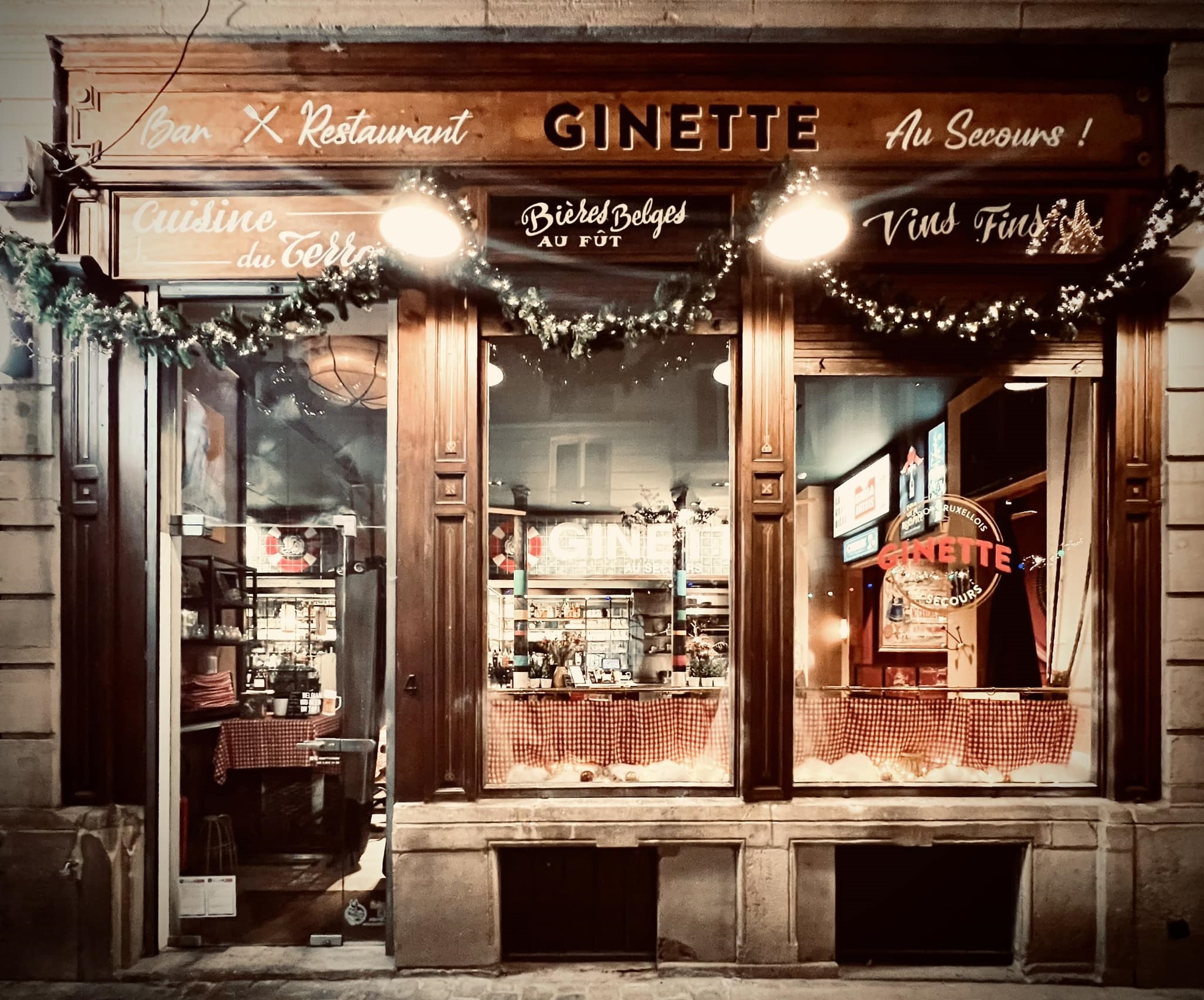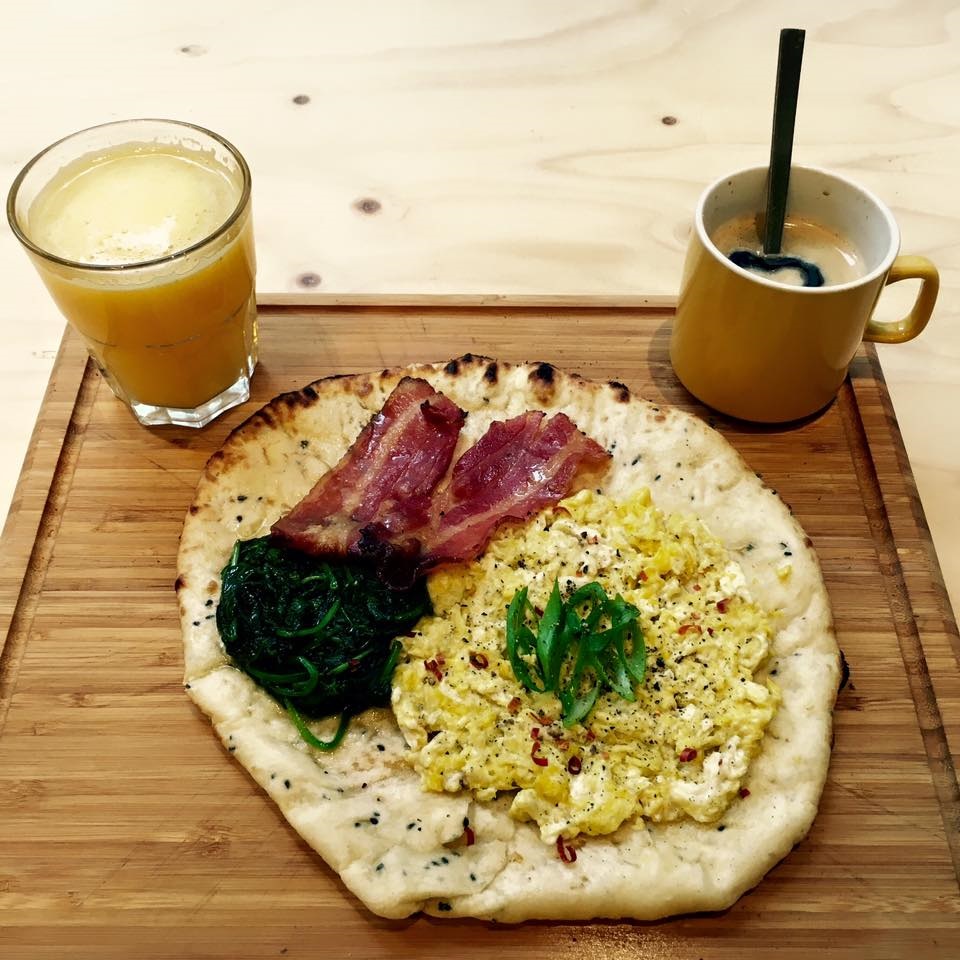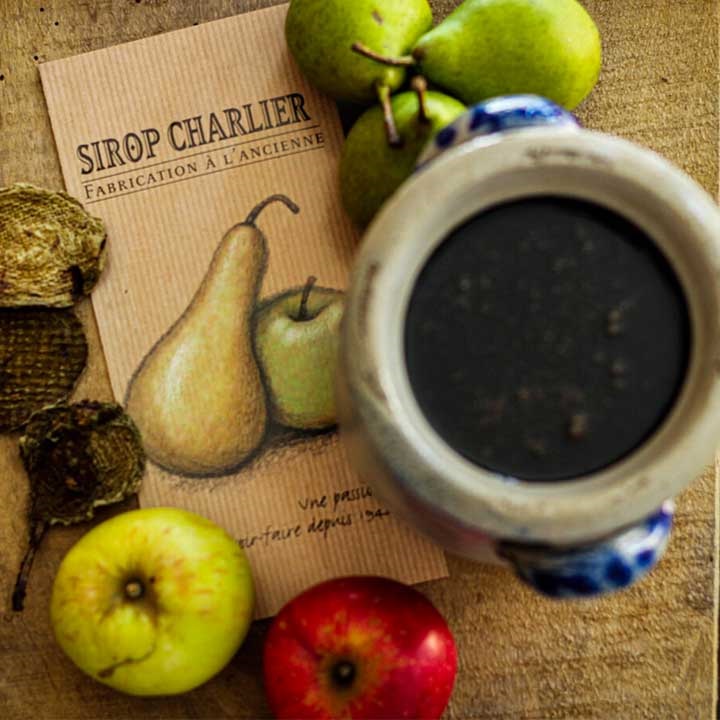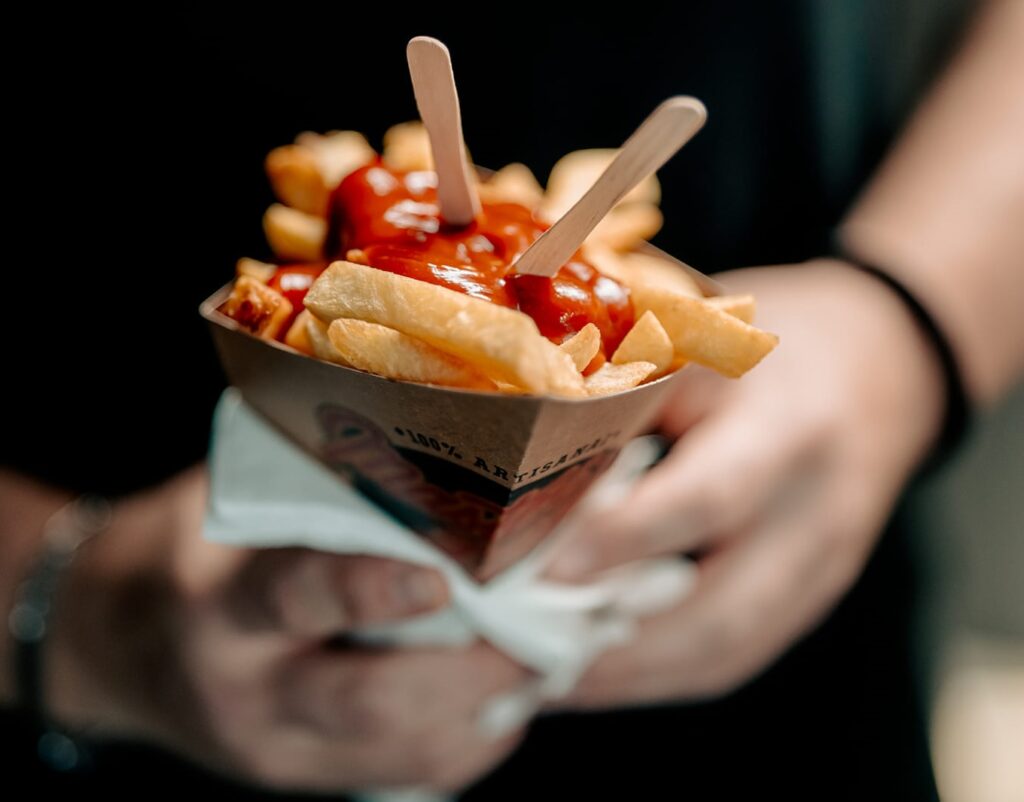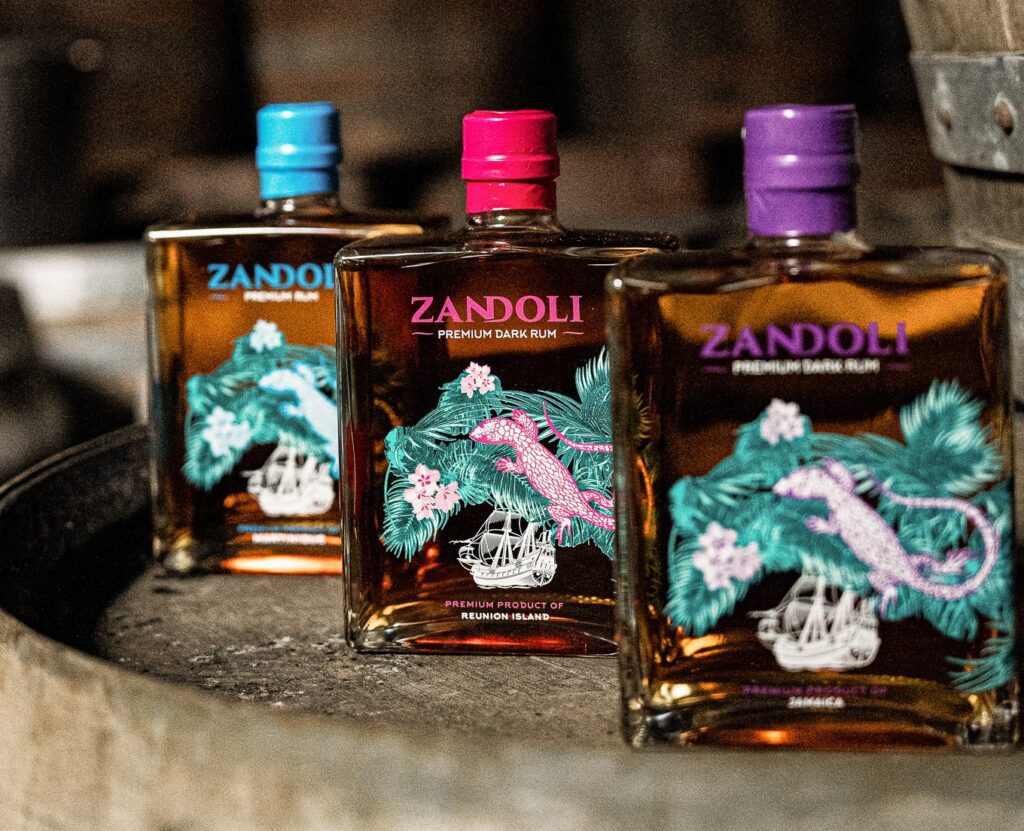What are the most delicious foods, refreshing drinks, coolest cafés and intriguing restaurants in Brussels at the moment?
Restaurant: Ginette Au Secours
I have finally found the brasserie of my dreams in Brussels: a place where you immediately feel at home, with the perfect warm Belgian atmosphere and food. It is in the heart of the city, a stone’s throw from La Bourse, just behind the Church of Notre-Dame de Bon Secours.
Wooden floors, banquettes, white and red chequered tablecloths and curtains foreshadow the traditional character of the menu. Here you can enjoy famous Belgian specials such as gratinated mussels, croquettes (shrimp and cheese), snails and cold cuts for the starters, as well as vol-au vent (chicken meat in white sauce), boulettes (meatballs) and carbonnade (beef stew) for the mains. The tiramisu au speculoos with a twist is presented like a cake (it contains even both boudoirs and speculoos), or you can opt for the gently cooked apple pie with vanilla ice cream.
What makes this place unique is that the entire menu (including fries and mayonnaise) is homemade by the boss Ferman Tavsi and his team – and you will notice the difference. Everything is cooked with love…and sometimes a little bit of spice. The service is quick and thoughtful. The drinks list is small but enough to pair with the food: you can try the organic beer Ginette with your Belgian favourites or pair your onglet à l’échalote with some Cochon, a fruity red natural wine from Provence.
Related News
Tavsi recognises that sometimes he needs to find creative solutions to store food and accommodate his customers at the same time. The restaurant is small, but there’s an even smaller side room for more intimacy. The table for two sits between the two rooms, half in the dark, and is the most romantic of the whole place. But wherever you sit, you’re sure to spend a magical moment in an authentic brasserie bruxelloise, so better book your meal in advance.
Ginette Au Secours 4, rue de Bon Secours 1000 Brussels
Food: Sirop de Liège
Sirop de Liège, an unusually thick syrup, has survived centuries of progress and industrialisation since it was invented in the 1600s, which says a lot about this delicious and historic fruit spread. Apart from being used like jam for a sweet gourmet moment, it also pairs incredibly well with some savoury specialities of Belgian cuisine such as carbonnades, duck, Liège-style meatballs and even a strong cheese like Herve.
The fruit is sourced from local growers before being washed, cooked for around 12 hours, pressed and cooked for another 2-4 hours in large copper cauldrons. About 800 grams of apples and pears make 100 grams of sirop de Liège. The final thickened product ranges from dark brown to black and its sweet flavour is balanced by a bit of sourness.
Depending on the fruit varieties used and the ratio of the two in the recipe, you can find doux (sweet) and/or sur (sour) syrup. A producer once told me that Francophones prefer the sweet one, while the Flemish prefer the sour one.
Today, not many understand the difference between artisanal syrups and their industrial counterparts. Over time, many farms became specialised and stopped producing syrup, and the industrial producers that took over took shortcuts by adding sugar and dates to increase sweetness and reduce the processing time.
Today there are only four family manufacturers who still stick 100% to the old recipe, which calls on apples and pears and nothing else: Nyssen in Aubel, Charlier-Royen in Henri-Chapelle, Thomsin in Thimister and Delvaux in Horion-Hozémont, in the Pays de Herve and Hesbaye regions next to Liège. They’re all founders of the Slow Food Presidium Sirop de Liège, a local association linked to Slow Food International, which guarantees the respect of traditional recipes based on heritage apple and pear varieties.
While you can find authentic sirop de Liège in Brussels markets, it’s even better to get it directly from where it is produced.
Café: Master Frites
It would be a crime not to feature this fritkot – especially if, like me, you don’t have a TV. This is because a recent show on broadcaster RTL chose Master Frites the best fritkot of Brussels – beating the more obvious, longstanding rivals – and the second-best of the realm.
We went to check if it was worth its new reputation for ourselves, and it was indeed a great place to enjoy genuine Belgian fries (or chips, if you prefer that term). Every morning, the potatoes arrive from Flanders and are carefully peeled before being cut to size. They are blanchies (a first beef fat bath at 160°C), then cooked at 180°C. The result: perfect fries, crispy on the outside and soft inside, with all angles slightly brownish. It looks simple but, it’s not that easy to find such perfection in all fries outlets of Belgium.
It's difficult to say exactly what part of this fritkot made the difference with its competitors. Is it the genuine warmth and care of the owners when they welcome and serve you? Is it the choice of homemade sauces, including a very hot one, that distinguishes it from the 200 others scattered around the city? Or perhaps it’s the burger menu: a dozen crazy combinations in a crispy bun, toasted to perfection inside and out. Start with the bestseller, the French burger, which includes a garniture of brie, honey and fried onions. Available alone or in a menu. Warning: portions are generous.
You won’t find any dessert here but coffee or tea from the owner’s reserve. There’s even some wine in the fridge for those who can’t content themselves with a Jupiler.
The counter and display of traditional snack food are also immaculate. The presentation, be it in a cornet to take away or in a paper leaf in its cardboard box to eat in the restaurant, enhances the quality of the (unsalted) fries. The atmosphere, inside (40 seats) or outside (20 seats), is peaceful with its brown-toned painting and forest wallpaper, despite a loudspeaker which produces more background noise than music.
The award was a well-deserved feat for Ilir, Astrit and Alban, three brothers from Kosovo who fled their country in the 1990s. They opened Master Frites in 2018 near Place Meiser and have recently opened a takeaway outlet in Ixelles. Worth a (regular) visit.
Master Frites 503, Chaussée de Louvain 1030 Schaerbeek
Drink: Zandoli
We often hear how Belgium has a language border, and if so, it is gastronomic as well. Both the Flemish and Walloons drink beer and wine, but they have clear differences in tastes for spirits.
“Walloons like brown spirits, whereas Flemish like white ones,” says Viviane Bajart from Oeno Belgium, the national leading merchant of made-in-Belgium’s wines and spirits. The exception is Peket, the Wallonian version of jenever that is mostly consumed at Francophones’ mass celebrations. Hence gin and jenever – and now tequila – thrive in Flanders, while whisky and rum made in Wallonia are a huge success in the south.
Dr Clyde Distillery produces a rum from Tirlemont’s cassonade called ‘Belgian brown sugar spirit.’ All other Belgian rum producers import rum from abroad (mainly Caribbean, but also Indian Ocean territories) and age it. Only a handful of Belgian rum producers macerate it (with vanilla, cocoa, blood orange or toffee), but most age their molasses in wooden barrels to give it a particular taste that depends on different ageing practices: old bourbon barrels, more or less charring, period of ageing, etc.
One year ago, the founders of successful Belgian gins Liégin and Sir Chill launched a range of three premium rums aged in Belgium called Zandoli. Named after a Creole lizard from the Caribbean, the rum comes in coloured bottles which look like perfume bottles. “It’s a more festive imagery than an old pirate,” acknowledges co-founder François Luthers, who suggests the fruity notes are popular with female customers. “Women start to like spirits, but they stay on the soft, sweet side, whereas men prefer stronger, more spiced ones,” Bajart explains.
The rum from Réunion has hints of litchee and caramel, with a very rounded flavour. The one from Martinique is imported after three years of ageing in bourbon casks. It is smokier and has hints of raisins, dates and candied fruits. Jamaican rum ages one year on the island before a further 1.5 years in Belgian bourbon casks where it takes aromas of overripe fruit and rubber.
“Belgians are surprised by the diversity of Belgian spirit production and attracted by its national character,” Bajart says. Zandoli founders were already working with Belgian distiller Rademaker when they extended their partnership to charring wood barrels as well as importing rum in bulk. The result is beautiful and tasty – another way to discover Belgium and its love for spirits.

